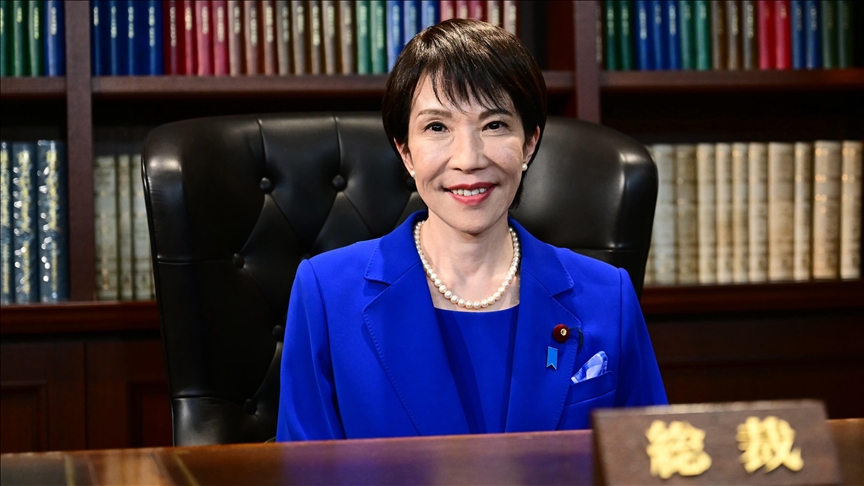BERLIN
Japanese nationalist and president of the ruling Liberal Democratic Party (LDP) Sanae Takaichi, who is expected to become the country’s first female prime minister, may take a stance against the Bank of Japan’s rate hikes, as she plans to lean on favoring more fiscal stimulus to encourage growth and tech competition despite debt problems.
The 64-year-old, nicknamed “Iron Lady,” plans to revive the economy with tremendous government spending. Preparations are underway to elect a new prime minister in Japan after Prime Minister Shigeru Ishiba’s resignation last month.
After a split between the LDP and Komeito parities which dissolved the 26-year-long ruling coalition, the LDP and the Japan Innovation Party agreed to form a coalition to pave the way for the country’s first female prime minister. The ruling and opposition parties will elect the new premier at a parliamentary session Tuesday.
Born in 1961 to a working-class family, Takaichi is the daughter of a father who worked for an automotive firm affiliated with Toyota and a mother who was a member of the Nara Prefectural Police. She studied business administration at Kobe University, graduating in 1984, and worked in the office of a US congresswoman in 1987.
Takaichi worked briefly as a television host and anchor for TV Asahi and later co-hosted the program Kodawari TV Pre-Stage. She then met Konosuke Matsushita, the founder of Panasonic, who inspired her to pursue a career in politics. She was elected to the House of Representatives in 1993 as an independent candidate and later joined the LDP.
Takaichi has been elected to the Diet 10 times in her over 30-year political career.
She advocates for expansionary government budgets and loose monetary policy as key drivers for growth and corporate profits. She says her goal is to solve social issues, develop technology, boost employment and reduce debt via public-private investments and natural tax revenue growth.
Analysts say that Takaichi is a supporter of fiscal expansion and a weaker Japanese yen, which is expected to further boost the Japanese stock market.
Takaichi was a supporter of the economic policy of her mentor, former Prime Minister Shinzo Abe, called Abenomics. She is expected to echo his policy and implement an economic plan that her supporters call “Sanaenomics.”
She bases her plan on the Bank of Japan’s keeping interest rates low and printing money. She proposes both a loose monetary stance and bold fiscal spending — a plan that prioritizes growth but considers fiscal discipline later.
Takaichi aims to revitalize Japan’s technological independence by calling for investments in strategic sectors such as infrastructure, semiconductors, green technology and space.
She argues that additional revenue generated by growth will make Japan’s debt burden, which is the highest in the world, somehow sustainable.
Call for BoJ to align with government policy
After taking the leadership seat at the LDP, Takaichi said that any decision the BoJ makes “must align with the government’s economic policy” during a press conference, emphasizing close coordination.
She shifted to a more moderate conservative line during her election campaign to get broader support within the LDP, avoiding controversial topics like lowering the consumption tax, opposing rate hikes, or visiting the infamous Yasukuni war shrine, which is viewed as a symbol of Japan’s wartime aggression by China, South Korea and other Asian countries, and the likely future prime minister declined to comment on whether she would continue visiting it if elected.
Takaichi’s polarizing reputation and past political stances pose risks, as analysts estimate that she may abandon cautious national debt consolidation, which could boost government bonds due to debt crisis concerns.
Bump to defense budget, ongoing geopolitical issues
Takaichi’s focus is not only on the economy, as she plans to strengthen Japan’s deterrence against threats from the region, primarily from North Korea and China, by increasing the country’s defense spending from 1% to 2% of gross domestic product (GDP).
She signaled a tougher stance on defense, which indicated that the country’s defense budget will increase in response to an increasingly difficult security situation.
Takaichi also wants to amend Article 9 of the Constitution, which prohibits Japan from maintaining a war-fighting force, in a bid to strengthen the military.
She is facing geopolitical challenges and more so if she continues to visit the Yasukuni war shrine, which is an act no incumbent Japanese prime minister has done in two decades, as it would damage the already fragile relations the country has.
She justifies her visits to the war shrine, saying war criminals deserve condolences due to being executed, but South Korea and China think otherwise, having suffered from Japan’s history of occupation.
Analysts say that if Takaichi advocates for economic populism and a more rigid nationalist stance, it would mark a significant departure from the Japanese government’s previous line.
Summits to attend, Trump’s visit
Takaichi is poised to become the first female prime minister in the LDP’s 70-year history at a Diet session on Tuesday. Her term, if elected, will end in September 2027.
If elected, she will attend the Association of the Southeast Asian Nations (ASEAN) and Asia-Pacific Economic Cooperation (APEC) leaders’ summits.
US President Donald Trump is scheduled to visit Japan on Oct. 27-29, which will be Takaichi’s first major diplomatic test if she becomes prime minister.
Until that happens, Japan’s previously stable politics will continue to be the crux of its economic and geopolitical uncertainties.
Anadolu Agency website contains only a portion of the news stories offered to subscribers in the AA News Broadcasting System (HAS), and in summarized form. Please contact us for subscription options.


AloJapan.com